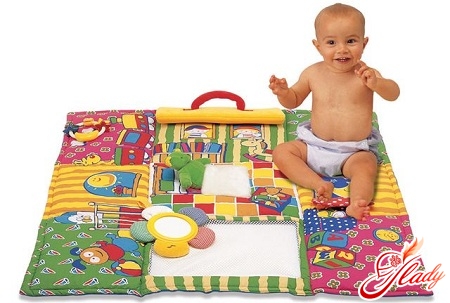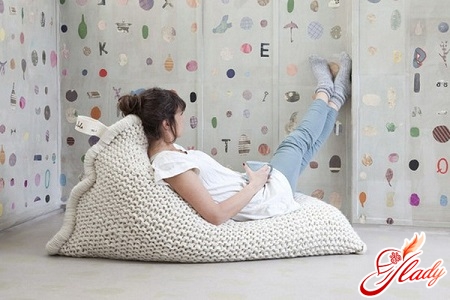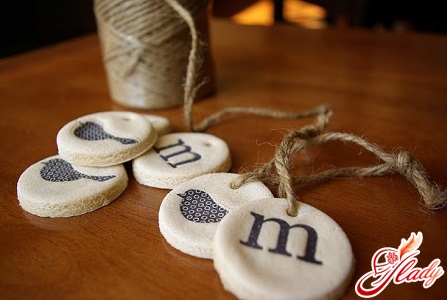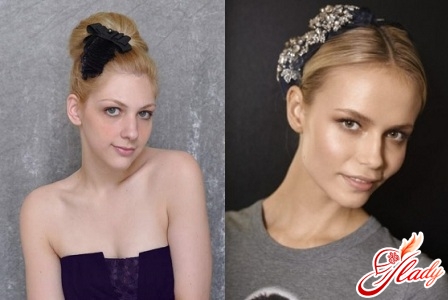 Parents have become more advanced these days!Everyone (somewhere deep down) is sure that they have given birth to a real indigo child and try in every way to get confirmation of this fact. And therefore, parents begin to develop their children practically from the cradle. But even if indigo children are just a pseudoscientific theory, everyone knows for sure that the best (smart, beautiful, quick-witted and talented) child is with every mother. And mothers, and along with them fathers, grandmothers and grandfathers selflessly devote themselves to the process of developmental education. One of the popular tools of such education has become a developmental mat. Children's goods stores offer them for every taste and at different prices. However, many young parents are not satisfied with either the quality of the product or its price. And sometimes they simply cannot find exactly what they consider necessary for their baby. Therefore, mothers have no choice but to sew a developmental mat for the child with their own hands or order it from a more skilled and freer grandmother or friend. Meanwhile, mats also come in different sizes and are intended for children of different ages. We invite you to learn about the varieties of this popular tool and how to sew a rug with your own hands.
Parents have become more advanced these days!Everyone (somewhere deep down) is sure that they have given birth to a real indigo child and try in every way to get confirmation of this fact. And therefore, parents begin to develop their children practically from the cradle. But even if indigo children are just a pseudoscientific theory, everyone knows for sure that the best (smart, beautiful, quick-witted and talented) child is with every mother. And mothers, and along with them fathers, grandmothers and grandfathers selflessly devote themselves to the process of developmental education. One of the popular tools of such education has become a developmental mat. Children's goods stores offer them for every taste and at different prices. However, many young parents are not satisfied with either the quality of the product or its price. And sometimes they simply cannot find exactly what they consider necessary for their baby. Therefore, mothers have no choice but to sew a developmental mat for the child with their own hands or order it from a more skilled and freer grandmother or friend. Meanwhile, mats also come in different sizes and are intended for children of different ages. We invite you to learn about the varieties of this popular tool and how to sew a rug with your own hands.
What are the developing mats for children
The earliest models of rugs are intendedfor children from three months to a year. This is the age when the child cannot yet move independently, but already shows an active interest in the space around him. He carefully examines all nearby objects, tries to reach them with his little hands and taste everything he can grab. Before the advent of developmental rugs, the child's attention was attracted by rattles stretched over the crib or stroller, with which he willingly played. Actually, it was these rattles that formed the basis of modern developmental rugs. The ideas for creating this newfangled "tool" simply lay on the surface. Therefore, it only remained to improve the principle itself and clothe it in a "modern" form. Which was done by the Israeli company Tiny Love about fifteen years ago. Such rugs, as a rule, in addition to bright colors and interesting toy details sewn onto them, are equipped with arches. Toys are also hung on the arches, which the baby can reach with his hands or simply examine while lying on his back. Models of rugs for children over one year old are slightly different. Such rugs are already hung on the wall near the crib or on the back of the crib itself. At this age, children begin to walk confidently and can handle this toy more consciously: fidget and pull various things, place removable elements on the rug or remove them from it. For children from one and a half to three or four years old, rugs are made with a plot. This is already a kind of stage (like in a puppet theater), on which children stage fairy-tale performances and plot games. In addition to exciting games, these rugs are also designed to teach the basics of arithmetic and develop logical thinking. That is, in addition to game elements, they are also equipped with educational elements. So if you are going to sew a rug yourself, then, believe me, you can make it much more interesting and versatile than store-bought models. It is only important to skillfully implement in practice all the ideas that have visited you. Well, of course, you need to try to sew a rug neat, beautiful and durable (the latter is especially important).
Ideas for making a rug
Look around for ideas.For the earliest rug, use not only “contemplative” elements, but also opportunities for developing fine motor skills. Games such as unbuttoning buttons and zippers, untying laces and bows, attaching (and “unfastening”) parts with Velcro and snaps are useful for this purpose. For a child from one to two years old, make a rug with mandatory removable elements that the child will use consciously. You can come up with a lake or river with fish that the baby will “catch” from the water. You can place a train or a car on the rug in which bunnies, bears or little people can “ride”. You can invite the baby to collect the “harvest” from trees and beds or put mushrooms and flowers in a basket. To introduce the child to natural phenomena, place the sun on the rug, which can set behind a cloud or clouds, from which it can rain or snow. In addition, already at this age, you need to start teaching your child to distinguish colors or geometric shapes. Therefore, provide the rug with elements of different colors and shapes: a round red ball, a round yellow sun, a green triangular roof on a house, blue rectangular carriages in a train, and so on. Ideas for creating a developmental rug for a child over two years old are more varied. Remember your child's favorite fairy tales and make a rug based on these tales. Sew a pirate or sea-themed rug for a boy, and make a fairy-tale kitchen or dressing room for girls. Here you can give free rein to your imagination and role-playing games: visiting, cooking dinner, treating animals. Such a rug should also contain more serious educational elements: numbers and letters. Use not only multi-colored fabrics for the developmental rug, but also textured elements: knitted, quilted, sewn from "rough" velveteen or drape. Volumetric parts can be stuffed with cereals (buckwheat, rice, peas) and smooth silk sliding fabrics can be used to depict water. It is advisable to use all sorts of rustling elements for the rug: bags and paper sewn into the fabric. Reflective surfaces: a compact disc or foil will also be interesting to the baby. Buttons can be used not only as a fastener, but also to make a path out of them or lay out pebbles on the shore. Well, and also for the development rug you need pattern appliques and all sorts of pockets.
Preparation for sewing a developing mat for a child
First, select fabrics for the rug.Don't limit your choice to just one type of fabric, use not only eco-friendly chintz, but silk, flannel, felt, denim or even tarpaulin. Be sure to check all the selected fabrics for resistance to washing: they should not fade or "shrink". Better yet, just wash and iron all the fabrics in advance. Choose strong accessories for the rug: plastic should not crumble or break, wood should be smooth and without burrs, zippers and buttons without sharp edges. Be sure to think over the theme of the rug and make a sketch. It is best if the "picture" is multifaceted: nature, city, transport, home - in a word, everything that surrounds the child in reality. For the rug, you will probably need additional accessories that can be turned into toys or made into parts of the rug. So look for and prepare large beads, small soft toys, rattles, old unnecessary belts, ribbons, ties and laces, boxes and other small items.
Sew developing mat for babies
And now the process itself.manufacturing. For the base, cut out a piece of thick fabric. Traditionally, this is a rectangle or square, but you can make the base round or triangular. If you are going to make a rug with arches, you will also need to prepare a frame made of thick wire. The lower part of the frame will be threaded along the perimeter of the base, and the arches will “fly up” above the rug. For a rug with a frame, sew a quilted base, filling it with padding polyester or foam rubber and leaving flat edges for fastening to the wire. Cut out the parts for wrapping the arches. Also wrap the arches with padding polyester and sew with fabric (you can do it by hand). Then twist the wire for the lower part of the frame to the shape and size of the base: rectangle, square, circle. Connect and fasten the ends of the wire and also wrap it with padding polyester. Attach the arches to the lower part of the frame and secure them securely. Also fasten the cross of the arches with wire or tie with a rope or cord. Now place the fabric base on the bottom of the frame and, wrapping the flat edges of the wire, firmly sew the base to the wire frame. By the way, for a more durable frame, its lower part can be made of plywood or a sheet of fiberboard, and then attach the arches to it. For this type of frame, make the base of the rug removable - like a mattress with fasteners. Sew voluminous and textured elements to the base, hang toys and rattles from the arches.
Sew a wall mat
For such a rug, you also need to sew it firstthe base, for which you also need to choose a dense fabric. The base can also be made from two types of fabric. Put a denser one (for example, denim) on the inside, and sew the front part of the rug from a soft and bright fabric (chintz, flannel). Process the edges and start implementing the sketch you have come up with. Cut out the details for the appliques and pockets from multi-colored pieces of fabric. Make patterns for the removable parts. First, attach the appliques to the rug and baste them. If everything suits you, sew the appliques to the base. It is best to do this with a zigzag stitch. Or you can glue them using an adhesive fabric and an iron. Only in this case, the edges of the appliques must first be overcast or hemmed. Sew on the cut out pockets, Velcro for removable parts and other elements that need to be sewn to the rug. Now work on the removable elements of the rug: figures, letters, numbers. Make patterns and craft volumetric parts, which you fill with the same padding polyester (for rustling ones - cellophane or paper). Sew fasteners (rings, ties) to the rug and you can present your creation to your baby. Surely, he will be pleased! You will also get no less pleasure when you see how interestedly the little one plays with the gifted toy. The development of the child is, of course, important, but maternal love is even more important for him. And what you do for your baby is done with love and charged with special energy. And what could be stronger and more important than love? We recommend reading:









